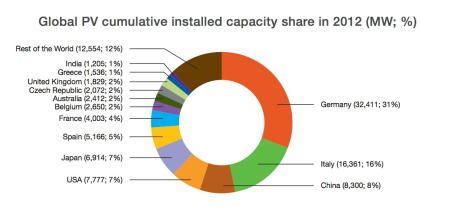In one of my previous article – titled Solar Basics – I discussed briefly the enormity of the energy received from the sun globally. Jamaica receives approximately 5kWh/m2 of solar radiation per day or 1800 kWh/m2 annually and thus possesses a great potential for solar applications such as electricity generation, water heating, and crop drying.
The amount of solar radiation a particular country receives is highly dependent on its geographic location, time of day, season, weather pattern and topography which explains why the western region of the US receives more solar radiation than any other region in that country, with an estimated peak of 3.58kWh/m2 per day or 1307 kWh/m2 per year.
Similarly, more than two-thirds of China receives solar radiation in excess of 1638.9 kWh/m2 per year, Munich in Germany is estimated to receive 1088 kWh/m2 per year and Japan receiving approximately 1000 kWh/m2 per year on average. Jamaica receives more solar radiation per square meter annually compared to Germany, Italy, China, USA, and Japan – the top 5 countries in terms of PV installed capacity. Contrary to this fact, Jamaica is light years behind these countries in PV installation. Germany is the world’s top PV installer, with a solar PV capacity of more than 32.3 gigawatt (GW), as of December 2012.
Solar PV installations in countries like Germany have led to a drastic reduction of the installation cost of PV, such that the cost of photovoltaic (PV) has fallen well below that of nuclear power since 2011 and is set to fall even further. The dramatic increase in PV installation in Germany, and the likes, is in fact due to financial incentive mechanisms such as subsidies, feed-in-tariffs, net-metering and Solar Renewable Energy Certificates (SREC’s). Often a combination of these mechanisms are used.
Subsidies – subsidies usually take the form of tax credits or rebates on the installation cost of your PV system.
Feed-in Tariffs (FiT) – in the FiT scheme customers sell surplus kilowatt-hours (kWh) produced by their PV system to the utility (JPS) at a price above that which the utility charges for kWh taken from the grid. This provide a greatest opportunity for customers, as the payback period of the PV system is drastically reduced and it can provide a stable income after the payback period elapses.
Net metering – net-metering refers to the case where the price paid by the utility is the same as the price charged, often achieved by having the electricity meter spin backwards as electricity produced by the PV installation in excess of the amount being used by the owner of the installation is fed back into the grid.
Solar Renewable Energy Credits (SRECs) – in this mechanism, a renewable energy production or consumption target is set, and the utility is obliged to purchase renewable energy or face a fine. The producer is credited an SREC for every 1,000 kWh of electricity produced. If the utility buys this SREC and retires it, they avoid paying the fine.
The slow growth in Jamaica’s Solar PV market points to the failure of the government to follow suit. Further incentives are definitely needed in the local PV market to give it the boost it so desperately desires – notwithstanding the recently introduced net-billing policy and the wheeling policy now being crafted. To further diversify our energy mix, reduce our greenhouse gas emissions, stimulate economic growth through the creation of high tech jobs and the development of an entirely new sector we must provide more incentives to sway prospective investors – both local and overseas.
To get where we want to go we must not be afraid to copy what other countries have done successfully. Japan for instance offered successful subsidies from 1994-2003 which put them in lead in 2004 with PV installation of 1.1GW. In 2004 the German Government introduced the first large-scale feed-in-tariff system which resulted in an explosive growth of PV installations, propelling Germany to the top of the PV installation chart with 32.2GWp. Other countries like China and the USA have since then follow suit. See the following pie for current PV installation statistics (click image to enlarge):
 Jamaica and the Caribbean at large has not done well in adopting the same approaches, but have instead made little strides in adopting similar but less effective mechanisms such as net-billing as oppose to net-metering for example. We need to be more ambitious in setting our renewable energy targets and be aggressive at achieving them. And in so doing be creative, if we lack the ability to be innovative I say copy what works for those who practice innovations year-in year-out! Life is not an examination, copying is allowed, so lets follow the leaning curve left by others until we find our own!
Jamaica and the Caribbean at large has not done well in adopting the same approaches, but have instead made little strides in adopting similar but less effective mechanisms such as net-billing as oppose to net-metering for example. We need to be more ambitious in setting our renewable energy targets and be aggressive at achieving them. And in so doing be creative, if we lack the ability to be innovative I say copy what works for those who practice innovations year-in year-out! Life is not an examination, copying is allowed, so lets follow the leaning curve left by others until we find our own!
Thanks for reading and I welcome your comments!


Well they spoke about passing legislation to allow for incentives in the 2030 Energy Policy. So we have quite a wait.
LikeLike
Contact me at Dexter@greensolarpower.org I plan to bring Solar PV to every parish in Jamaica over the next 5 years
LikeLike
Will do!
LikeLike